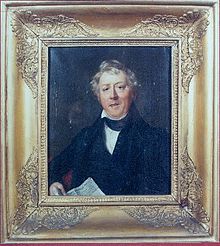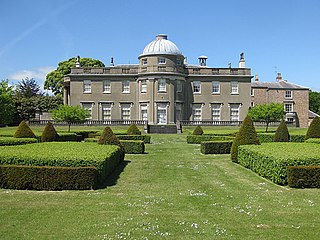






The Palmes family of Naburn Hall, and the cadet branches of Lindley Hall, North Yorkshire; Ashwell, Rutland; and Carcraig in Ireland, are an ancient English aristocratic family, noted for their adherence to Catholicism.







The Palmes family of Naburn Hall, and the cadet branches of Lindley Hall, North Yorkshire; Ashwell, Rutland; and Carcraig in Ireland, are an ancient English aristocratic family, noted for their adherence to Catholicism.
The family were originally seated at Taunton Deane, Somerset, where Manfred de Palma/Palmes had by the "Gift of Milo Earl of Hereford & Constable of England, 53 Oxgangs of Land and 25 Messages in the Lordship of Taunton Dean". [1] Manfred was "known to be living in the sixth year of the reign of King Stephen, 1140 AD". [2]
The Palmes family of Naburn can trace its ancestry through a maternal line to Robert de Todeni (died 1088), a powerful Norman baron. Todeni's importance is reflected by the 80 estates in 11 counties that he was granted by William across England. His principal Lordship was at Belvoir where he built his home, Belvoir Castle, before establishing Belvoir Priory in 1076. [3] Among Todeni's many estates was Naburn. In 1226, William Palmes of Taunton acquired the Lordship of Naburn through his marriage to Matilda, daughter or sister of Richard de Watterville; a direct descendant of Robert de Todeni from whom the land had passed to the Wattervilles. From then on, the estate continued to descend uninterrupted from father to son within the Palmes family until 1974, on the death of Commander George Bryan Palmes. [4] The Palmes family were said to have been "unique in being able to boast an unbroken heritage". [4] Edmund Burke described the family as "one of serious antiquity". [5]
The will of Brian Palmes, Sergeant-at-Law, of Naburn Hall, was dated 31 October 1519. It shows that in addition to Naburn the family held estates in: Riccall, Escrick, South Duffield, Elvington, Barthorpe, Sutton, Holtby, Berrythorpe and Gate Fulford. [6] A cadet branch of the family was seated at Lindley Hall, North Yorkshire, and an Irish line of the family settled at Carcraig. [7]
The manor house of the Palmes family – Naburn Hall – is first recorded in 1345. It had eight hearths in 1672. A drawing of circa 1720 shows it as a two-storey house, three bays long, with attic windows in tall pointed gables. The house was remodelled in 1735 by Brian Palmes (1696–1737), who was married to Anne, daughter of Robert Scarisbrick of Scarisbrick Hall. The hall was again altered in 1818 by George Palmes (1776–1851). In 1870, it was restored and enlarged to the designs of William Atkinson, though the 18th century interior and central block remained unchanged. The main three-storey square block of rendered brick and stone dressings has a concealed slate roof. In the 19th century, a two-storey wing was attached. Attached to the rear of the hall is the derelict yellow brick and tile Chapel of St. Nicholas, originally built in the 16th century by Nicholas Palmes (died 1551) of Naburn, so his family could continue to practice Catholicism. The chapel was rebuilt in 1870. The Coach house and Stables were built in the late 18th century with a Pedimented Clock tower and domed bell-turret. A one and a half-storey Gate Lodge was built on the main road in the early 19th century, with a central stack, slated roof and veranda. [8]
Guy Palmes was the brother of Bryan Palmes of Naburn Hall, and like him also a Serjeant-at-law during the reign of Henry VII and Henry VIII. His son and heir, Brian, married Isabell (died 1550), daughter and co-heir of Thomas Lindley, of Lindley, North Yorkshire. Their son, Sir Francis Palmes, acquired the Lordship of Lindley and established the family at Lindley Hall, renouncing his Catholic faith to become a Protestant. His great-great-grandson, William Palmes of Lindley, married the Hon. Mary Eure, younger daughter and co-heir of William Eure (died 1645), 6th Baron Eure. Their only surviving son died without issue and Lindley was acquired by their son-in-law, Sir William Strickland, 3rd Baronet, of Sizergh Castle, the husband of their youngest and only surviving daughter, Elizabeth.
Several members of the family have married into the peerage, this includes:
Sir Brian Palmes raised a regiment for King Charles I; subsequently he was compounded for his estate by the Parliamentarians. [12]
The family had links to the Fairfax family through the marriage of Janes, Sir Guy Palmes' daughter to Sir Nicholas Fairfax, son of Sir Thomas Fairfax of Denton, Yorkshire, [13] this couple were the grandparents of Thomas Fairfax, 1st Viscount Fairfax. [14] Sir Guy Palmes initially opposed King Charles I and later became an ardent Royalist. [15] His son Sir Bryan Palmes was a Royalist also. [16]
The Palmes family were Nonconformist; in the 17th century they received quietuses for recusancy fines. [17] Catholicism excluded the Palmes family from public office and they seem to have retreated to their estates, though their pedigree indicates that they continued to marry well, usually to other large landed Catholic families like the Langdales and the Stapletons. [18]
The heir of Brian Palmes, Nicholas Palmes (died 1551) of Naburn Hall, married twice and left an heir, Brian Palmes (d. circa 1581), whose second wife, Anne, was the daughter of John Constable of Burton Constable Hall. These two generations of the Palmes family were the first to be affected by The Reformation. Coming from a family who for several generations had been admitted of Corpus Christi, York, they were not swift to abandon their Catholicism and Brian Palmes was the first member of the family to be recorded as paying a recusancy fine in 1577. Unfortunately for the Palmes family they were rather visible, as Naburn Hall stood two miles downstream on the opposite bank to the palace of the Archbishop of York on the River Ouse and they went on suffering fines for non-attendance at church until they changed religious allegiance in 1784. Until that time their Catholicism meant that half the village of Naburn was Catholic as well, while the other half of the village followed the Protestant example of the Baines family at Bell Hall. [19]

Lord Fairfax of Cameron is a title in the Peerage of Scotland. Despite holding a Scottish peerage, the Lords Fairfax of Cameron are members of an ancient Yorkshire family, of which the Fairfax baronets of The Holmes are members of another branch. From 1515 to about 1700 the family lived at Denton Hall.

Scampston Hall is a Grade II* listed country house in North Yorkshire, England, with a serpentine park designed by Charles Bridgeman and Capability Brown. It is located on the north side of the A64 Leeds/Scarborough road, 4 miles (6 km) east of Malton, in Scampston village. The name of the village was referred to in various ways in ancient documents as: Scamestun, Skameston, Skameston, and Skampston, and was probably derived from a personal name.

Ashwell is a village and civil parish in the county of Rutland in the East Midlands of England. The population of the civil parish was 290 at the 2001 census falling to 269 at the 2011 census. It is located about 3 miles (5 km) north of Oakham.

Naburn is a small village and civil parish in the unitary authority of the City of York in the ceremonial county of North Yorkshire, England. It lies on the eastern side of the River Ouse about 4 miles (6.4 km) south of York. According to the 2001 census the parish had a population of 470, increasing to 516 at the 2011 census.

Three baronetcies have been created in the Baronetage of England for members of the Littleton or Lyttelton family. All three lines are descended from Thomas de Littleton, a noted 15th-century jurist. Despite differences in the spelling of the title, the names of all three lines were spelt in many varied ways in the early modern period, without distinction between the different branches of the family. This can be confusing, as the range of forenames in use was very limited.

Sir William Strickland, 3rd Baronet of Boynton, Yorkshire was an English landowner and Whig politician who sat in the English and British House of Commons between 1689 and 1724. He was also a notable racehorse owner.
Thomas Levett, was an Oxford-educated Lincoln's Inn barrister, judge of the Admiralty for the Northern Counties and High Sheriff of Rutland. But Levett's chief accomplishment was as antiquarian, preserving a centuries-old chartulary kept by Cluniac monks at their Pontefract, Yorkshire abbey, and then turning it over to Yorkshire medieval scholar Roger Dodsworth for publication.
Sir Guy Palmes (1580–1653) was an English landowner and politician who sat in the House of Commons at various times between 1614 and 1643.
The Baronetcy of Goodricke of Ribston was created in the Baronetage of England by King Charles I on 14 August 1641 for his loyal supporter John Goodricke of Ribston, Yorkshire. He represented Yorkshire in the Cavalier Parliament from 1661 to his death.
Sir Bryan Palmes (1600–1654) was an English politician who sat in the House of Commons in 1626 and 1640. He fought on the Royalist side in the English Civil War.
The Hon. Philip Sherard was an English soldier, landowner and politician who sat in the House of Commons from 1660 to 1685.

Lieutenant-General Francis Palmes was a noted favourite general of the Duke of Marlborough. He served in Lord Cavendish's Regiment of Horse and Hugh Wyndham's Regiment of Carabiniers, eventually rising to become lieutenant-colonel of the latter regiment. He fought at the Battle of Blenheim in command of a brigade. Often employed as a diplomatic envoy as well as a soldier, Palmes died at Dresden in 1719.

Brian Palmes was an English landowner, justice of the assize and politician who sat in the House of Commons.
Sir William Babthorpe (1489/1490–1555) was an English politician of Osgodby and Flotmanby, Yorkshire.
Sir Nicholas Fairfax, of Gilling Castle and Walton, Yorkshire, was an English politician.
William Palmes, of Lindley, North Yorkshire and Ashwell, Rutland was an English landowner and Whig politician who sat in the English and British House of Commons between 1668 and 1713.

Sir Ralph Euer, also known as Ralph de Eure, of Witton, Stokesley, Berwick Hill, Darreshall, Kirkley, Felton, Ayton, Malton and Boughton Spittle was an English knight and servant of the Crown and of the Bishops of Durham. He was also a Member of Parliament for Northumberland and Yorkshire.

William Eure, 2nd Baron Eure was a Tudor-era English nobleman, soldier, and official in the Scottish Marches.
Bennet Sherard of Whissendine JP DL was an English politician who served as a Member of Parliament for Rutland.
William Eure, 4th Baron Eure was an English nobleman.